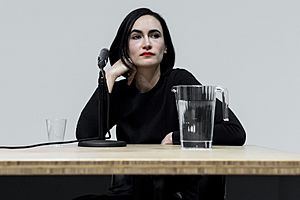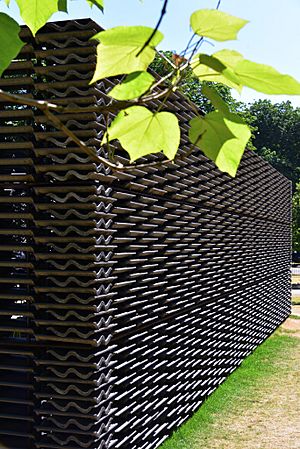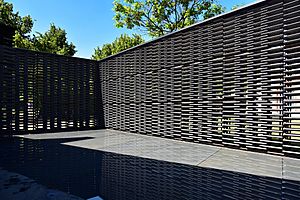Frida Escobedo facts for kids
Quick facts for kids
Frida Escobedo
|
|
|---|---|

Escobedo in 2014
|
|
| Born | 1979 (age 45–46) Mexico City, Mexico
|
| Alma mater | Universidad Iberoamericana |
| Occupation | Architect |
| Buildings | La Tallera |
Frida Escobedo, born in 1979, is a talented architect from Mexico. She designs and fixes up buildings in cities, like homes, community centers, art places, and hotels. When she designs, Frida thinks about how buildings connect with people and their lives today, not just history. She started her own design studio in Mexico City in 2006. Escobedo is known for creating temporary and interactive designs that can be used for many different things.
In 2018, she became the youngest architect to design the Serpentine Pavilion in London. She was also the second woman invited to do this, after Zaha Hadid in 2000. Her architectural work includes projects like the courtyard at La Tallera in Cuernavaca. Her artistic projects can be seen at places like the Museo Experimental el Eco in Mexico City or the Victoria & Albert Museum in London. Because of her work on the Serpentine Pavilion, ArchDaily named Escobedo one of the top 30 most important architects in London.
Contents
Becoming an Architect
Frida Escobedo studied architecture at the Universidad Iberoamericana. She also earned a master's degree in Art, Design, and the Public Domain from Harvard's Graduate School of Design. Since 2007, she has been teaching at the Universidad Iberoamericana. She has also taught classes at other famous universities. These include Columbia University’s Graduate School of Architecture, Harvard Graduate School of Design, and the Architectural Association School of Architecture in London.
Escobedo works as an independent architect in Mexico City. She enjoys working with other architects on projects.
Early Life and Discovering Architecture
As a child, Escobedo often went with her father to the hospital where he worked. She would spend time looking out the window at nearby homes. She said she was "trying to understand how space reflects people’s personalities." She realized that buildings can show people's feelings and relationships.
Frida didn't always know she would be an architect. She said, "I was 17 when I had to decide what career I needed to choose." However, she always knew she wanted to work in a creative field. After her first week of architecture school, she knew it was her true passion.
Key Projects and Designs
In 2003, Frida Escobedo started a studio called "Perro Rojo" with Alejandro Alarcón. One of their well-known projects was "Casa Negra." This house was designed for someone who wanted to live surrounded by nature. It was influenced by how a camera works. The house is lifted above the ground on four tubes. It has a large window that offers a wide view of Mexico City. This makes it feel like you are looking through a big camera.
In 2006, "Perro Rojo" closed, and Escobedo started her own architecture and design company. She has been designing under her own name ever since.
Interactive Art and Public Spaces
In 2010, she created an art piece at the Museo Experimental el Eco. It had movable cement slabs that could be used for talks and speakers. In 2013, she designed a circular arena. In 2015, she created mirrored structures in the courtyard of the Victoria and Albert Museum. When she designs, Escobedo often explores the idea of time. She focuses on how buildings relate to society and people's lives today.
In 2018, Escobedo designed the Serpentine Pavilion in London's Kensington Gardens. She used materials and styles from both Britain and Mexico. This helped her create a design that showed the history and culture of both countries. The Pavilion was open to the public from June to October 2018. The design was inspired by the courtyards often found in Mexican homes. It had walls made of British cement with a lattice pattern. This allowed light and wind to pass through. The open yet enclosed design made it feel a bit mysterious. She also added a small pool and a mirrored ceiling. These created a play of light and shadow that changed throughout the day, showing the passage of time.
Unique Material Use
In 2019, Escobedo designed a bag for Salvatore Ferragamo S.p.A.. It was inspired by ancient Mexican designs. She used a concrete block pattern from her design of the Mar Tirreno 86 house in Mexico City.
Also in 2019, Escobedo used special rammed earth from the Mixteca area of Oaxaca, Mexico. She used it for the bricks in her design of Aesop's store in Park Slope, Brooklyn. She said this earth has a "completely different texture and tone" than regular bricks. Her team arranged the bricks in unique stacks, creating a grid that stood out in the store. Escobedo studied patterns by artist Anni Albers to help with this design. The store was a 19th-century building that used to be a vet clinic. This was her seventh project with Aesop.
Major Museum Renovation
In 2022, Escobedo was chosen to redesign a part of the Metropolitan Museum of Art in New York. This part is called the Oscar L. Tang and H.M. Agnes Hsu-Tang Wing. The museum's director, Max Hollein, said that Frida Escobedo is a great architect. He noted her ability to create powerful spaces and her careful use of materials. She also pays attention to important social and environmental issues. Escobedo is the first woman to design a wing at The Met.
For each new project, Escobedo explores many ideas before creating her design. For example, when she designed "System_01" for an exhibition in Geneva, she thought about ancient sites like Stonehenge. She also considered Native American tepees and old lake-dweller huts. Even drawings of spiderwebs and old math books inspired her. The "System_01" has three round wooden parts of different sizes. They are designed using math and are very open, like viewpoints. They create spaces for people to use and enjoy. Escobedo believes that a building is truly finished only when people start to live in and use it.
Notable Works
- 2004 – Casa Negra (with Alejandro Alarcón) – Mexico City
- 2006 – Hotel Boca Chica Restoration (with José Rojas) – Acapulco, Mexico
- 2010 – Pavilion at the Museo Experimental el Eco – Mexico City
- 2012 – Restoration of La Tallera, Cuernavaca, Mexico
- 2013 – Plaza Cívica – Lisbon
- 2015 – Installation at the Victoria & Albert Museum
- 2018 – Serpentine Pavilion 2018 – London
- 2019 – Aesop Park Slope – Brooklyn, New York
- 2022 – System_01 Pavilion – Geneva
- 2022 (announced) – Oscar L. Tang and H.M. Agnes Hsu-Tang Wing renovation, The Met – New York
Awards and Recognition
- 2004 – Young Creators' Scholarship from the Fondo Nacional para la Cultura y las Artes, Mexico
- 2009 – Winner of the Young Architects Forum, Architectural Association of New York
- 2012 – Her work was shown at the Venice Biennale of Architecture
- 2014 – Ibero-American Biennale of Architecture and Urbanism Prize
- 2016 – Emerging Architecture Award, Architectural Review
- 2017 – Architectural League Emerging Voices
See also
 In Spanish: Frida Escobedo para niños
In Spanish: Frida Escobedo para niños




